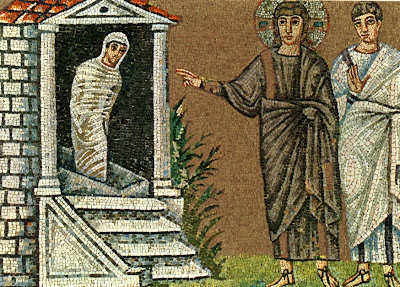ZOMBIE LAZARUS

Mosaic
6th century
Basilica of Sant' Apollionare
("This is one of the most important buildings from the period of crucial cultural significance in European religious art". http://en.wikipedia.org/wiki/Sant%27Apollinare_Nuovo)
Ravenna, Italy
(Ravenna was the seat of the Roman Empire in the 5th century and then of Byzantine Italy until the 8th century. It has a unique collection of early Christian mosaics and monuments. Ravenna rose to power in the 1st century BC under the Emperor Augustus. The town converted to Christianity very early, in the 2nd century A.D. As Rome's power declined, Ravenna took over as capital of the Western Empire (402 A.D.) The following century it came under the rule of Thedoric and the Arian Ostrogoths and in 540 the city became part of the Byzantine Empire under Justinian. These early christian mosaics span the years of Roman, Ostrogothic, and Byzantine rule.)
Zombie Lazarus
The artwork here reminds me of a zombie, and thus leads me to the question "could this resurrection have been a staged event?". But, then you might ask,"Are zombies real or myth?" In the 1970's a young botanist, Wade Davis, was sponsored by the AMA to spend time in Haiti gathering research of the "zombie potion" in hopes of finding new sources for anesthesia. He spent many years among the voodoo doctors (houngans) and has written much of his experiences and findings.
Zombification is used as a punishment for those who continually cause problems and break laws. Sometimes a powder might be sprinkled on the persons doorstep and absorbed through the feet, or administered in some other indiscriminate way. These "special powders" cause the person to fall into a trance and the heart rate is slowed. For all intent and purposes, the person appears dead. The effects are so convincing that coroners have signed death certificates and funerals and burial have taken place. In past times, the houngan would dig up the person after burial, revive them, and they would be sold as slave labor to another tribe. Even though the person would be revived, the potion causes brain damage, and thus the person becomes a "zombie".
Could something like this have happened to Lazarus?
Another thing to notice in this mosaic is the "eye" in the pyramid above Lazarus. Is this a hidden message of some sort? Why is this pyramid and eye so often repeated in mysterious religious artworks?
